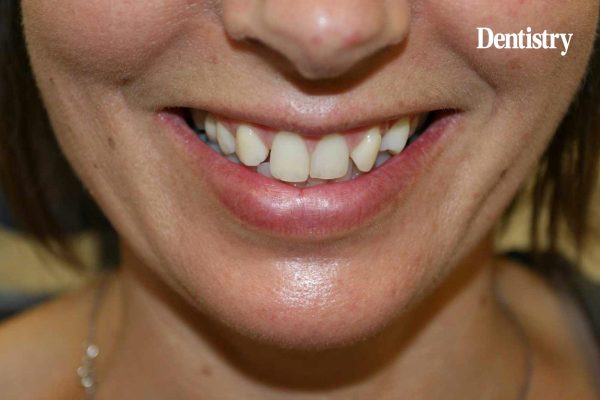Hitesh Gohil describes treating a patient with missing upper lateral incisors, with composite edge-bonding that remained stable for 10 years.
When patients come to see me and I provide their treatment plan, I want to make sure they feel they can put their faith in me.
An important factor is being able to demonstrate the high performance of the materials I select for their treatment.
Reassurance that these will deliver predictability, long-term wear and lasting value for money is critical to establish the bond of trust between patient and clinician.
A lady in her mid-to-late 40s came to see me because she was not happy with the appearance of her upper dentition. The upper lateral incisors were missing due to a congenital condition (Figure 1).
The patient had previously undergone orthodontic treatment to close the spaces. She had never been fully satisfied with the outcome and desired a more even, natural-looking smile with reduced interdental gaps.
Examination and treatment planning
There had been an earlier attempt to improve the patient’s smile and reduce the sharpness of her upper canines by drilling them down. Her general oral health and diet were very good.
Following examination, I recommended a short course of anterior orthodontic treatment to achieve subtle shape changes and better alignment, as the starting point for composite edge-bonding or minimal-preparation porcelain veneers. However, the patient was involved with theatrical work and therefore did not want to wear braces, even for a short period of time.
She was also not keen on porcelain veneers, which left me with composite edge-bonding as the only viable treatment option.
There were several challenges to overcome with the agreed plan. The width of the canines would be difficult to disguise. The blending of the premolars to resemble canines would also be problematic (Figures 2 and 3).
The restorations needed to deliver an aesthetic result to meet the patient’s wish for an improvement to her smile, balanced with placement of the optimum volume of composite for lasting durability.
Preparation and freehand restoration
There was no need for invasive preparation of the patient’s upper dentition. They were isolated under a rubber dam and separated with polytetrafluoroethylene (PTFE) tape. The teeth were etched with 37% phosphoric acid gel, followed by application of a single-step bonding adhesive.
Composite edge-bonding was carried out, tooth by tooth, with Kulzer Venus Pearl A2 shade (Figure 4). The composite’s durability is something I have come to depend upon. I also find it very easy to handle, whether for multi-layer or single-layer placement. Venus Pearl doesn’t slump, maintains its shape well and offers reliable shade matching.
Using the patient’s upper right central incisor as a guide, the UR3, UR4, UL1, UL3 and UL4 were restored. The edge-bonding proceeded freehand, with small, incremental layers to gradually bring the teeth into alignment. The final layer of composite was placed in one piece and carefully blended towards the tooth margins. It was then light-cured through glycerine to prevent the oxygen inhibition layer.
The restorations were polished using a set of discs, from coarse to super fine. A final polish was carried out with diamond polishing paste and goat hair brushes.
Lasting value
The patient’s smile line was assessed. At this stage, it was noted that the UL5 gave the appearance of being slightly recessed. Accordingly, I decided to build up the UL5 to bring the buccal corridor in line with the rest of the teeth. The final polish was carried out using Shofu Super-Snap polishing discs and diamond polishing paste.
The patient was overjoyed when I revealed the result to her (Figures 5 and 6). She had convinced herself that the treatment would only be a halfway house. However, she ended up with a complete, natural-looking transformation and was genuinely overwhelmed.
The lady has also continued to attend the practice for regular reviews. Apart from very minor staining that I usually polish out, there has been no evidence of chipping after almost 10 years (Figures 7 to 9).
This article first appeared in Dentistry magazine. You can read the latest issue here.


